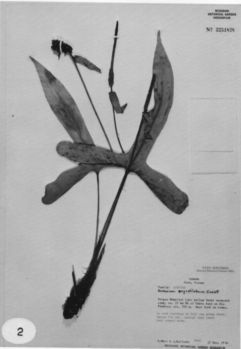


Anthurium angustilobum Croat, sp. nov.
TYPE: Panama. Panama: Gorgas Memorial Labs yellow fever research camp, ca. 25 km NE ofCerro Azul on Río Piedras, 550 m, near fork in river, Mori & Kallunki 3462 (MO 2251828, holotype; K, PMA, isotypes).
Planta rupicola; cataphyllum persistens in fibris tenuibus; petiolus (9.5-)14-27 cm longus; lamina trilobata, lobis gracilibus posterioribus, subcoriacea, basi acuta, 10-20 cm longa, 15-19 cm lata; inflorescentia erecta; pedunculus 18-32 cm longus; spatha viridis, subcoriacea, lanceolata, 4÷4.5 cm longa, 8-10 mm lata, stipite 4-10 mm longo; spadix 6-8 cm longus; baccae rubrac, obovoidae, 5.5-6 mm longae.
Growing among rocks; stems ca. 1.5 cm diam.; leaf scars obscured by cataphyll fibers; cataphylls 7-8 cm long, drying brown, weathering to fine, longitudinal fibers persisting around stem.
LEAVES erect-spreading; petiole (9.5-)14-27 cm long, 2-3 mm diam.; geniculum ca. 1 cm long; blades subcoriaceous, 3-lobed, long-acuminate at apex; acute at base, 10-20 cm long, 15-19 cm wide, broadest at base; anterior lobe 10-20 cm long, posterior lobes 4-9 cm long; matte on both surfaces (dry); midrib raised above, more prominently raised below, basal veins 4-5 pairs, the first free to the base, those remaining coalesced 1-3.5 cm; primary lateral veins 3-6 per side. departing midrib at 20-25¡ angle, straight to collective vein, raised above and below; lesser veins prominulous above and below, collective vein arising from the first basal vein, loop-connecting the primary lateral veins in the median lobe, 3-4 mm from the margin.
INFLORESCENCE usually erect; peduncle 18-32 cm long, ca. 3 mm diam.; spathe green, subcoriaceous, lanceolate. 4÷4.5 cm long, 8-10 mm wide, broadest near the base, acuminate at apex, acute at base; stipe 4÷ 10 mm long; spadix cylindroid-tapered, 6-8 cm long, 4-5 mm diam. at base, 2-3 mm diam. at apex (dry); flowers rhombic, 2-2.4 mm long, 1.5-1.7 mm wide, the sides straight to weakly sigmoid, 5-6 flowers in the principal spiral, 6-7 flowers in the alternate spiral; lateral tepals 0.5-0.7 mm wide; pistils scarcely emergent: stigmas linear; stamens emerging from the base, in a more or less prompt sequence, the alternate stamens preceding the third and fourth stamens by ca. 6 spirals; anthers held over pistil; thecae ovate. slightly divaricate.
INFRUCTESCENCE erect or spreading, berries red, obovoid, 5.5÷6 mm long, 4-5 mm diam., rounded at apex, mesocarp thickly gelatinous; seeds 1-2, 3.7-4.2 mm long, 2.8-3.5 mm wide, flattened when 2-seeded- enveloped in sticky substance extending beyond base and apex. Fig. 2.
Anthurium angustilobum is known only from the type locality in Panama in an area of tropical wet forest at 550 m. It is an apparent member of section SemaeophyIlium and is distinguished by its thick, deeply three-lobed leaves with slender posterior lobes usually more than three times longer than broad and with the lowermost basal vein marginal to the sinus along most of its length. Also characteristic are the stipitate spadix and red berries.
The species appears not to be closely related to any other members of section Semaeophyllium and may be more closely related to certain members of section Belolonchium that have a tendency for well-developed lateral lobes. Anthurium angustilobum superficially resembles A. seleri Engl. from Mexico but that species differs in that the dried leaf has more numerous veins spreading at a much broader angle from the midrib (mostly 40-60¡). In contrast, those of A. angustilobum ascend at an angle of 20-25¡ from the midrib.

Panama: Gorgas Memorial Laboratory, NE ofCerro Azul on Río Piedras, Mori & Kallunki 3462 (K, MO, PMA).